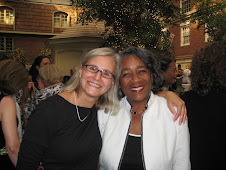The Who What When Where and How strategy engages students by tapping into youth culture and Hip Hop. Basically, students write a four-beat song to demonstrate their thinking on a particular topic.
Chorus: (all students sing)
Who, What, When, Where and How
Who, What, When, Where and How
Verse: (individuals or groups of students sing--see sample below)
In World Literature I employed this strategy to make their setting brace map come to life. Student groups were assigned a setting in The Handmaid’s Tale. They dissected the setting description to come up with people (cast), props (objects) and infrastructure (scenery). Those were the main brace map parts, and students dissected those main parts into the sub-parts of concrete nouns that would appear in those areas of the brace map if they were directing a play of the book.
From the brace map students easily wrote the Who What When Where and How song. Here’s an example of a verse hanging on my student Hall of Fame from The Handmaid’s Tale for Offred’s bedroom.
WHO: Offred Alone
WHAT: She lives simply
WHEN: Most of the time
WHERE: A Tiny Room
HOW: Forced to Remain
Each line has four beats. I lined up a singing volunteer from each group in front of the room so that the students could sing the story. The entire class sang the chorus between each verse. The chorus is just Who, what, when, where and how repeated twice. The entire class also did a call and response, calling out who, and letting the appropriate singer answer.
This day was met with mixed reviews from "one of the best classes ever" to "I am not going to sing."
Showing posts with label music. Show all posts
Showing posts with label music. Show all posts
Tuesday, March 18, 2008
Monday, October 15, 2007
Jabari Mahiri: NUA Culture Consultant
 photo from UC Berkley
photo from UC BerkleyJabari Mahiri, a professor at UC Berkley and former English teacher in Chicago public schools, presents culturally responsive strategies at National Urban Alliance workshops and conferences. Marhiri's book Shooting for Excellence: African American and Youth Culture in New Century Schools is given to NUA cohort participants and is an excellent starting point for discussing issues of race and teen culture in the classroom.
For a list of all of Mahiri's publications and for more biographical information, visit his Berkley home page.
The Edina CoP will discuss chapter 4 of Shooting for Excellence entitled "Changing Classroom Discourse and Culture" at their next meeting on Nov. 27.
Here is a brief breakdown of what is contained in the subheads of Chapter 4:
- "Classroom Discourse" explains teacher talk and control
- "Classroom Culture" discusses tracking and institutional structures
- "Problems of Changing Classroom Discourse and Culture" includes information on the history of hatred and racism in schools and contrasts Ms. Jackson's World Literature class with her Ethnic Literature class, which is a tracked, low-level class.
- "Possibilities for Changing Classroom Discourse and Culture" analyzes Ms. Park's classes and her emphasis on building relationships.
- "Culture and Curriculum" discusses the need to connect with teen culture, and rap music is explored as one way to do this. Mahiri provides lesson ideas that do not involve listening to rap music, but rather reading and writing about text-based material about rap.
Sunday, September 16, 2007
Soundtrack Assignment
As a final project for Catcher in the Rye, American Lit teachers will have students create a soundtrack of the songs that remind them of the books themes or characters. Each soundtrack song is accompanied by one paragraph that explains why the song was chosen. This assignment really allows students to showcase their teen culture.
Here's a full description of the assignment:
Here's a full description of the assignment:
The Catcher in the Rye Soundtrack
Most movies today come with a soundtrack of songs and music heard in the film. These songs sometimes are incidental (i.e., not important) to the film, but other times they add meaning to the plot or highlight the emotional aspects of particular characters.
For this assignment, you must create a soundtrack for The Catcher in the Rye that represents theme, illustrates growth of character, and reflects the plot meaningfully. The soundtrack that you create should be appropriately and respectfully representative of the novel.
Here are specific criteria:
1. You must have a minimum of eight songs. You may choose any kind of music. You may want to think about having a “theme” to your music; that is, have all music be from one genre. (WWHLT? What would Holden listen to?)
2. At least three of these songs must be for specific characters. That is, find a song that best represents each character you choose. In essence, this should be the character’s “theme song.”
3. At least three songs must be meant for specific scenes of the novel. Focus on specific, meaningful scenes. Ask yourself: if this scene were made into a movie, what music would be played in it?
4. At least one song must represent a theme found in the novel overall.
5. Not all the music you choose must have lyrics. Instrumental selections are also appropriate.
6. For each song you choose, you must write a paragraph explaining your choice. Comment on the connection between the music and the novel. The song must fit the character/scene/theme well. For each song, use at least one quotation from the book as support for your choice. Also, you will probably want to quote specific lyrics in your discussion. Make sure you offer insightful reasons to justify your selections and connections.
7. You must either provide lyrics for each song or make a tape/CD with the music on it. You may wish to just present the lyrics that would be heard in the movie, or you may provide the entire lyrics since the full song would appear on your soundtrack.
8. Create the cover jacket for the CD soundtrack jewel case (front and back). The cover should include the name of the CD and at least one visual reference to the novel; the visual(s) should also connect to the characters/scenes/themes that you emphasize on the soundtrack. Other text that you may wish to include on the front or back: a list of the songs/performing artists, credits, recording company information, dedications, lyrics. Push your creativity here.
Most movies today come with a soundtrack of songs and music heard in the film. These songs sometimes are incidental (i.e., not important) to the film, but other times they add meaning to the plot or highlight the emotional aspects of particular characters.
For this assignment, you must create a soundtrack for The Catcher in the Rye that represents theme, illustrates growth of character, and reflects the plot meaningfully. The soundtrack that you create should be appropriately and respectfully representative of the novel.
Here are specific criteria:
1. You must have a minimum of eight songs. You may choose any kind of music. You may want to think about having a “theme” to your music; that is, have all music be from one genre. (WWHLT? What would Holden listen to?)
2. At least three of these songs must be for specific characters. That is, find a song that best represents each character you choose. In essence, this should be the character’s “theme song.”
3. At least three songs must be meant for specific scenes of the novel. Focus on specific, meaningful scenes. Ask yourself: if this scene were made into a movie, what music would be played in it?
4. At least one song must represent a theme found in the novel overall.
5. Not all the music you choose must have lyrics. Instrumental selections are also appropriate.
6. For each song you choose, you must write a paragraph explaining your choice. Comment on the connection between the music and the novel. The song must fit the character/scene/theme well. For each song, use at least one quotation from the book as support for your choice. Also, you will probably want to quote specific lyrics in your discussion. Make sure you offer insightful reasons to justify your selections and connections.
7. You must either provide lyrics for each song or make a tape/CD with the music on it. You may wish to just present the lyrics that would be heard in the movie, or you may provide the entire lyrics since the full song would appear on your soundtrack.
8. Create the cover jacket for the CD soundtrack jewel case (front and back). The cover should include the name of the CD and at least one visual reference to the novel; the visual(s) should also connect to the characters/scenes/themes that you emphasize on the soundtrack. Other text that you may wish to include on the front or back: a list of the songs/performing artists, credits, recording company information, dedications, lyrics. Push your creativity here.
Sunday, August 26, 2007
Bryonn Bain: Hip Hop in the Classroom
 photo from bryonnbain.com
photo from bryonnbain.comBryonn Bain, who has joined the National Urban Alliance as its Artist-in-Residence, is Brooklyn's Famed Spoken Word Poet. Bain currently teaches at Columbia University and at Riker's Island Prison. Bain first came into the national spotlight when he was falsely imprisoned by the NYPD during his second year at Harvard Law School. Following his false imprisonment, Bain wrote the article "Walking While Black" for The Village Voice, and that article earned him a Mike Wallace interview on 60 Minutes.
For more information about Bryonn, visit his website bryonnbain.com.
Bain proposes that it is important for teachers today to connect to teenagers through music, and since the music that many teens, regardless of their cultural backgrounds, listens to is Hip Hop, teachers should be incorporating Hip Hop into their lessons. In fact, Bain asserts that 70% to 80% of Hip Hop consumers are white, suburbanites. Bain, in a WMEP/NUA Reunion class on March 7, 2007, cautioned the teachers present not to be racist in their critique of Hip Hop.
During the NUA Hip Hop session, Bain briefly lectured on the components of Hip Hop--the DJ, the graffiti artist, the B-Boy or B-Girl breakdancer, and the emcee (also known as the spoken word poet or rap artist). Many people think of Hip Hop only as the rap portion of the Hip Hop culture. Bain claims, "Rap is something you do; Hip Hop is something you live."
Bain proposes that teachers use Hip Hop in the classroom not only as text to analyze, but also teachers should have students create their own Hip Hop. Creating Hip Hop works especially well in history classes because Hip Hop can tell the story of a historical event. Besides connecting to youth culture, teachers who employ Hip Hop in the classroom will be promoting creativity and discovery, using rhythm, rhyme and repetition to enhance memory and verbal skills, and they will be allowing listening and dancing to release student stress.
Bain's Hip Hop lesson ideas have been greatly influenced by Paulo Freire's Pedagogy of the Oppressed. For an excerpt of Freire's book and a look into his educational philosophy, click here.
James McBride, author of The Color of Water, would most likely agree with Bain's assessment because McBride discussed the importance of Hip Hop in the world today in the April 2007 issue of National Geographic. McBride's article traces Hip Hop back to its African roots and proposes that music is a great equalizer among people.
NUA Culture Consultant Augusta Mann holds a similar view that teen culture today has its basis in African American culture.
Subscribe to:
Posts (Atom)






